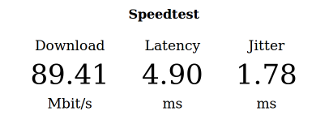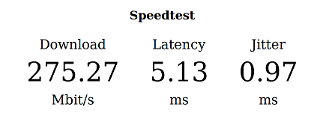The discussion comes up, relatively often, here on the forums, about the relative advantages of various network connectivity technologies. Often, in these discussions, WiFi gets a bad rap. I've maintained that's because most home WiFi systems are... not optimal [note 1].
One of the options often discussed is powerline Ethernet adapters (or "bridges"). WiFi has been working well for us [note 2], but I was curious as to how well powerline Ethernet bridging would. Did my research [note 3] and chose for my test Comtrend G.hn 1200 Mbps Powerline Ethernet Bridge Adapter 2-Unit Kit PG-9172KIT [note 4].
As most people purchasing such devices have found: The manufacturer's promises, vis-a-vis throughput, are exceedingly optimistic. I think the best I ever saw, with the two of them on relatively benign branch circuits on the same side of our home's split-phase service, was a couple hundred Mb/s. The good news is the worst I ever saw, using the most hostile setups I could find [note 5], was 60Mb/s to 80Mb/s. And, even in those hostile hookups connectivity seemed pretty stable.
But how did these things perform feeding a streaming device, as opposed to the WiFi connection we've been using? The following two screen shots tell the story:

That's a Channels speed test from a computer to the Fire TV Gen. 2 on the TV in the family room, using the Comtrend G.hn powerline Ethernet bridges [note 6].
Compare to the same thing done with the Fire TV on our wireless LAN:

Over three times the bandwidth, nearly identical latency and nearly half the jitter. The point here being WiFi isn't necessarily the worst choice, as it's sometimes made out to be.
Conversely: Sometimes powerline Ethernet bridges will win.
I did two tests of the powerline Ethernet bridges where they definitely out-performed WiFi in our environment. The first was to a corner room in the basement, with the laptop sitting on my lap. That's about as far from the AP as I can get and still be in the house. The laptop would get only ±17Mb/s on wireless, but averaged ±75Mb/s on powerline. The powerline tests were over several days, at various times of the day and evening.
Out in our shed, about 60 feet (18m) from the back of the house and about 85 feet (26m) from the AP [note 7], WiFi did only about 3Mb/s [note 8]. The Comtrend powerline bridges performed at a solid 70Mb/s.
Admittedly, none of this is very scientific. It's just some tests/demonstrations under just some particular sets of circumstances.
Notes:
- In fact most home WiFi networks use poor hardware and their access points (more often WiFi routers) are often poorly-sited.
- Our WiFi access point is centrally-located and is business-class hardware.
- "Research" was mostly Amazon reviews and a bit of light web searching
- The Comtrend G.hn product was chosen more for its ratings for reliable connections than the fastest ones.
- Worst-case setups were with each node at the far ends of branch circuits, putting as much house wiring between each node as possible. One was across the phase split, the other had the slave node on the busiest, noisiest branch circuit in the house.
- Computer and powerline bridge (at one end) both connected directly to home LAN's "backbone" Etherswitch. (So is the WiFi AP.)
- About 120 wire-feet (37m) from the distribution panel.
- Shed WiFi test was on 2.4GHz. 5GHz wasn't strong enough to establish an iperf3 connection back to the server. Test device was an iPad, rather than the laptop. (It was an afterthought.)
